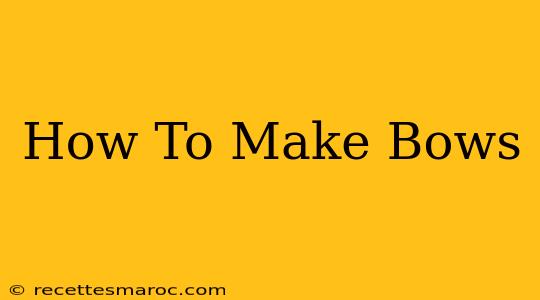Making bows is a fun and rewarding craft, perfect for adding a touch of elegance to gifts, hair, or even clothing. Whether you're a complete beginner or looking to expand your bow-making skills, this guide will walk you through various techniques and styles. Let's dive in!
Essential Materials for Bow Making
Before you begin, gather these essential materials:
- Ribbon: This is the star of the show! Choose from a wide variety of widths, colors, patterns, and textures to suit your project. Consider satin, grosgrain, wired ribbon, or even fabric scraps.
- Scissors: A sharp pair of scissors is crucial for clean cuts and precise shaping.
- Hot Glue Gun (Optional but Recommended): While some simpler bows can be tied, a hot glue gun offers a much more secure and professional finish. Always use caution when working with hot glue.
- Floral Wire or Thread (Optional): Useful for creating more intricate bows or securing delicate materials.
- Decorations (Optional): Add embellishments like beads, gems, flowers, or other decorative elements to personalize your bows.
Basic Bow Making Techniques
Here are a few fundamental techniques to master:
The Classic Bow
This is the quintessential bow, simple yet elegant.
- Cut your ribbon: Cut a length of ribbon approximately 18-24 inches long. The longer the ribbon, the larger your bow.
- Fold and Loop: Make a loop on one end of the ribbon, then create another loop of the same size on the opposite end.
- Cross the Loops: Cross the two loops over each other.
- Tie and Secure: Wrap a short piece of ribbon around the center and tie a tight knot. Trim the ends of the ribbon for a neat finish. For added security, consider securing the knot with hot glue.
The Layered Bow
This bow adds depth and visual interest.
- Cut multiple ribbon lengths: Cut several lengths of ribbon in varying widths and lengths.
- Make individual loops: Create loops for each ribbon length, following the steps for the classic bow.
- Layer and secure: Layer the loops on top of each other, using the largest loops as the base and arranging the smaller ones on top. Secure the center with ribbon or hot glue.
Advanced Bow Making Techniques
Once you've mastered the basics, try these advanced techniques:
Wired Ribbon Bows
Wired ribbon allows for more intricate shaping and holds its form beautifully.
- Shape the loops: Carefully bend and shape the loops of the wired ribbon to create curves and points.
- Secure with wire: Use floral wire to secure the loops in place and create a more defined shape.
Fabric Bow Making
Fabric bows offer a unique texture and allow for more creative designs.
- Cut fabric shapes: Cut out multiple fabric circles or squares.
- Gather and shape: Gather the fabric edges and shape them into loops. Secure with thread or glue.
- Assemble the bow: Layer and arrange the fabric loops to create your desired design.
Tips for Perfect Bows
- Practice makes perfect: Don't be discouraged if your first few attempts aren't perfect. Keep practicing to refine your technique.
- Experiment with different ribbons: Explore various ribbon types, widths, and patterns to find your favorites.
- Add your personal touch: Personalize your bows with embellishments and unique designs.
- Use hot glue carefully: Always use caution when working with a hot glue gun to prevent burns.
Beyond the Basics: Creative Bow Applications
The possibilities for using your handmade bows are endless. Consider these ideas:
- Gift wrapping: Add a handmade bow to any gift for an elegant touch.
- Hair accessories: Create beautiful hair bows for yourself or others.
- Clothing embellishments: Add a bow to a dress, bag, or other clothing item.
- Decorative accents: Use bows to decorate wreaths, cards, or other craft projects.
With a little practice and creativity, you can create stunning bows for any occasion. So grab your ribbon and get crafting!

